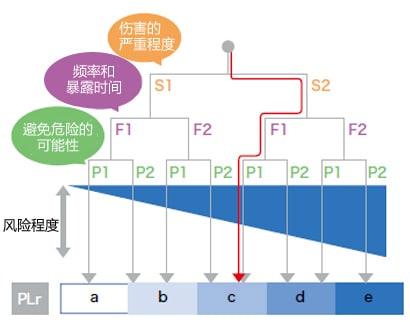PLr and PL (from ISO 13849-1:2006)
performance class | Hazard per hour |
a | ≥10-5 or <10-4 |
b | ≥3 × 10-6 or <10-5 |
c | ≥10-6 or <3 × 10-6 |
d | ≥10-7 or <10-6 |
e | ≥10-8 or <10-7 |
Performance Level (PL) values are used to define the ability of safety-related parts of a control system to perform safety functions under foreseeable conditions. On the other hand, the required performance level (PLr) is used to achieve the required risk reduction for each safety function. Therefore, the performance level (PL) of the safety-related parts of the control system must be higher than or equal to the required performance level (PLr).
Determination of required performance level (PLr)
For each safety function performed by the safety-related part of the control system, the required Performance Level (PLr) must be determined according to the following three parameters:
severity of injury
S1:slight
S2:Serious (eg irreversible injury and death)
Frequency and/or time of exposure to hazards
F1:Rarely to infrequent and/or short exposure time
F2:Frequent to continuous and/or prolonged exposure
Avoid danger or limit the possibility of injury
P1:possible under certain conditions
P2:almost impossible

Evaluation example
In the following cases: PLr in shall be determined as "c".
Severity of injury: Severe (S2)
Frequency: Rarely (F1)
Likelihood to Avoid: Likely (P1)




